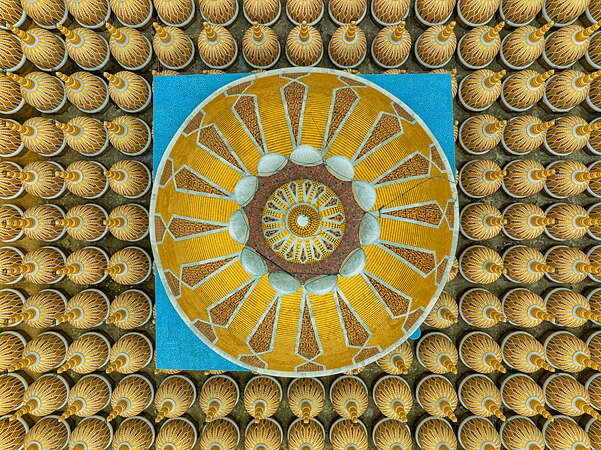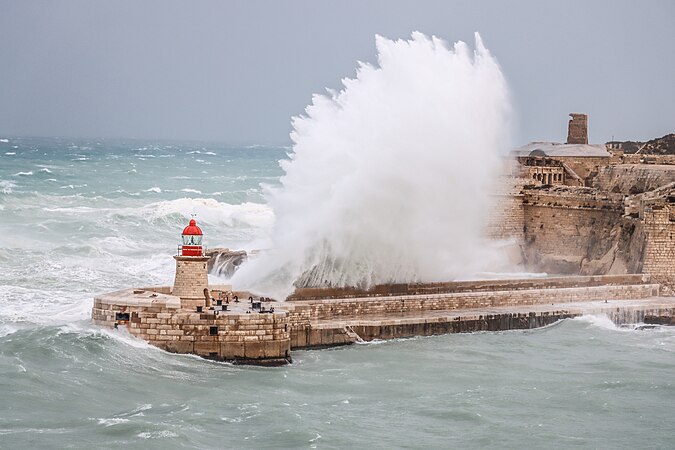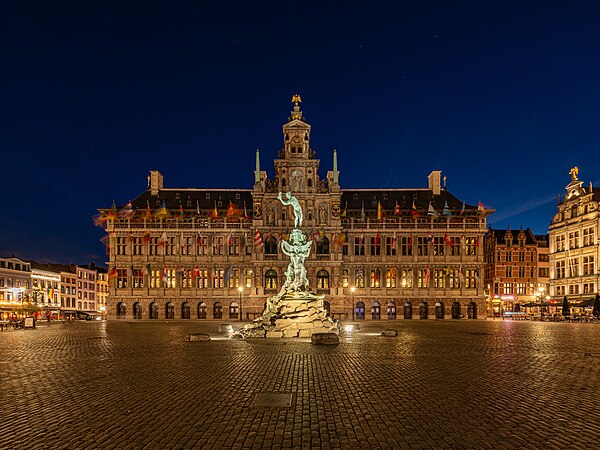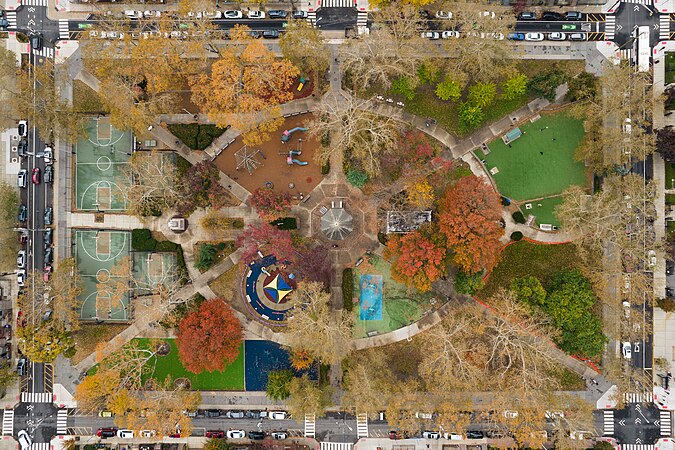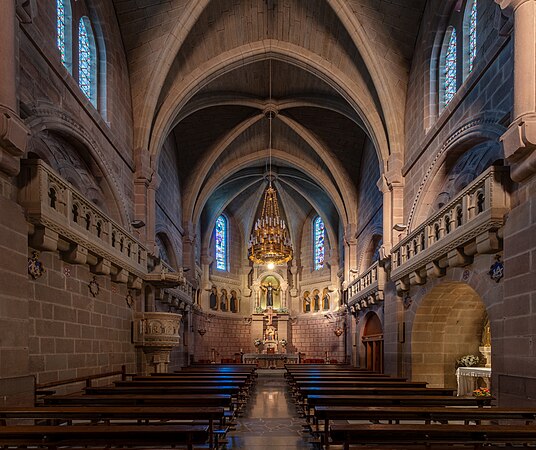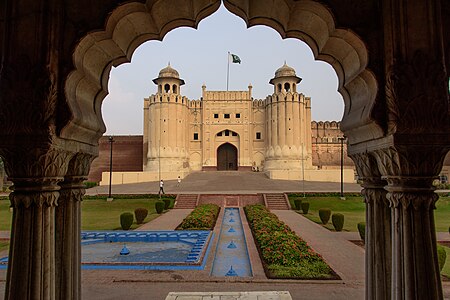Commons:Wiki Loves Monuments 2023/Jury report
| WLM 2023 | Participating countries | Uploaded images | Organizers | FAQ | Help desk | For organizers |
Introduction
editThis is the fourteenth year in which Wiki Loves Monuments has been organised. In 2023, over 218,000 photos were submitted by more than 4,600 users. As was the case throughout the history of the competition, the contest was organised through a number of national contests coordinated by local volunteers. Each national jury then submitted up to 10 photos to the international stage of the contest. In this year’s edition 43 national competitions have submitted their nominations, resulting in a total of 387 entries for the international jury to consider.
As in previous years, Wiki Loves Monuments 2023 invited people to submit photos of monuments listed within their respective national competitions throughout the months of September and October. It is heartening to see Wiki Loves Monuments maintain its popularity over the years, and even in this latest edition there was an increase in the total number of submissions and the number of participating countries compared to previous years.
In this report we provide some insights in the judging process and outcomes. The report includes a summary of the process steps and announces the winning photos. We have also included the finalists that did make it to the final selection of 44 photos, but did not win a prize. The reasons why the jury members have selected these photos as their top ranking winners are included in this report as well.
Wiki Loves Monuments is the largest photography competition in the world, and reaching this finale is an accomplishment in itself. We congratulate all photographers who have submitted photos that reached this level. We hope you will enjoy the collection of wonderful heritage photographs as much as we did through the jury process and in preparing this report.
How did the jury work?
editNational competitions, which took place throughout the months of September and October, submitted their nominated photos by 5 December. At this time, a total of 387 were submitted to the non-voting jury coordinator by the national juries of 43 national competitions. These were joined by three others who did not send their images, making a total of 46 participating countries. Each national competition was allowed to submit up to 10 photos. Certain countries elected to submit fewer photos. The international jury was tasked to come up with a final ranking of the top photos over a three-round jury process.
The nominations were collected in the jury tool ‘Montage’, where all 10 jury members independently rated all photos from 1 (poor) to 5 (very good) stars. The jury coordinator collected the photos with the highest average rating: 56 photos.
Jury members were invited to comment via email on these 56 photos and the selection in general, and if any three jury members agreed through a ‘veto’ process that a photo does not belong to the top 25, it would be removed from the selection for the third round. Through this process, 12 photos were removed, and therefore 44 photos remained on the ‘long list’ for the third round.
In the third and final round, the jury members used the jury tool to rank their top-25 from the remaining photos. They each selected 25 photos, and submitted them in order. A first place ranking by a jury member was worth 25 points, a second place 24 points, all the way to 1 point for a 25th place. These points were added together, resulting in a combined jury ranking. Ties were resolved by the highest rank the photos received. The jury members had the opportunity both in the second and the third round to give a reasoning for their vote, which was used as a basis for the jury comments in this report.
What did the jury do?
editThe international jury was made up by a group of ten experts with varying backgrounds in photography, heritage and Wikimedia, as well as with a diverse range of cultural backgrounds doing justice to the diversity of Wiki Loves Monuments’ participating photos. Members of the international jury did not participate in the national juries, which were excluded from consideration for the international finale. The international team would like to thank them for their service.
The jury members based their judgement on three main criteria:
The first criterion is about the quality of the photo itself. This includes considerations such as the sharpness and resolution, the use of light, and the perspective of the photo. A good rule of thumb is that a winning photo should fulfil the Wikimedia Commons technical criteria for ‘featured picture’ status.
This criterion takes into account the general originality or innovation of the competing photo. The jury looked into whether the subject had been photographed in a similar way before. Jury members were looking for that little ‘extra’ that your photo may contain.
One of the main goals of this competition is to collect good-quality photographs of monuments to be used on Wikipedia. This criteria reflects this consideration. Does the photo represent the monument clearly and can it be used in an encyclopaedic context? Is it misrepresenting the monument in any way, or are there any distracting details?
Who was on the jury?
edit- Rodrigo González: He is a photographer from Mexico City and an active contributor to Commons, focusing on political communication, monuments and landscapes. He has been part of the Wiki Loves Monuments jury in Mexico.
- Wilson Oluoha: Born in Lagos, Nigeria, he is a multi-lingual Information and Media Scientist with a passion for open access to knowledge and building sustainable knowledge communities. He joined the Wikimedia movement in 2018 through the Igbo language affiliate in Nigeria. In 2022, he founded IG WikiCommons Hub.
- Heidrun Rosenberg: She is an art historian, lecturer and independent curator. She is currently a board member of Wikimedia Austria.
- Bijay Chaurasia: A Nepal-based professional photographer, specialises in landscape, travel, cultural, and monumental photography. With a decade of experience, he’s captured Nepal’s allure. A dedicated Wikimedia contributor since 2014, he promotes Nepal’s charm worldwide.
- Libardo Muñoz: Volunteer in Wikimedia Colombia, he enjoys translating and recording articles from Wikipedia and participating in activities about open knowledge.
- Nassima Chahboun: She is a Moroccan architect, urban planner, and heritage consultant, holding a MA in Architecture & Historic Urban Environments from University College London. She is the founder of the heritage consultancy firm “CultureLab”, and the co-founder of “Wiki World Heritage User Group.”
- Nicola Dell’Aquila: He has always been in the world of photography: his father is an art and architecture photographer and he learned from him. He is the photographer of the Egyptian Museum in Turin since 2016, focusing on digitization of the collection (open data project) and on documenting museum’s life.
- Vanj Padilla: She is a Philippine journalist and a Doctor of Laws graduate. She is a communications strategist and a public relations officer. As such, she works with photojournalists and learned photography skills, visual artistry, branding and design. She has been a Wikimedian since 2012 and has been Wikimania COT in 2021 and 2023.
- Onur Palabiyik: Born in 1961, and currently living in Turkey, he retired after having worked as a Civil Engineer. In 2010, he started his journey in the world of photography, and he is proud to hold the titles of EFIAP/b and GPU 2.
- Rebecca Jeannette: She is the Co-Founder of Wikimedia User Group Rwanda and Community Engagement Director at Wikimedia Rwanda. She leads initiatives like Wiki Loves Monuments every year in Rwanda, Wiki for Human Rights and WikiGap while championing environmental safety through OSM Rwanda.
Competition Winners
editGiza Pyramids during "Forever is Now" exhibition. It is a contemporary art exhibition sponsored by the Egyptian Ministry of Tourism & Antiquities, the Egyptian Ministry of Foreign Affairs, and the National Commission for UNESCO, that brings together regional and international artists.
The photo illustrates the added value of artwork to existing monuments and the synergy that can be created between the two. The picture’s angle and distance were very well chosen to create a balanced and proportional scene.
Marksburg Castle in winter, with the striking chimneys of the Braubach lead and silver smelter, one of the oldest industrial monuments in the Middle Rhine region, to the right. Built around 1117 to protect the town of Braubach, of the 40 hill castles between Bingen am Rhein and Koblenz, Marksburg was one of only two which had never been destroyed (the other being Maus Castle).
Very well balanced, the smoke’s line serves as a connection between the two buildings, creating the effect of an interaction between the present (embodied by the factory) and the past (embodied by the palace).
The image shows a panoramic view of Premana, a municipality in the province of Lecco, in the Italian region Lombardy.
The photo perfectly captures the synergy between the natural and the man-made environments, and illustrates the position of the village within the mountains. Aesthetically, the soft contrast between the late evening sky and the house's lights adds a lot of warmth and power to the village’s composition.
St Andrew's Church is an Orthodox church in Kyiv, constructed between 1747 and 1754 to a design by the Italian architect Bartolomeo Rastrelli. Situated on a steep hill, where Andrew the Apostle is believed to have foretold the great future of the place as the cradle of Christianity in the Slavic lands, the church overlooks the historic Podil neighbourhood.
The monument stands, in all it's cold coloured beauty, against the warm sunset. I think this photo shows both a beautiful moment and monument.
The image shows an aerial view of the Buddha Dhatu Jadi, a temple located close to Balaghata town, in Bandarban City. Dhatu are the material remains of a holy person, and in this temple the relics belong to Buddha. It is the largest Theravada Buddhist temple in Bangladesh and has the second-largest Buddha statue in the country.
The photo provides important architectural information on the building’s plan, composition, and materials. Aesthetically, the photo is balanced in terms of forms and colours, and the shadows are well captured.
-
Haghartsin Monastery
Photographer: Vladimir Pankratov
Location: Dilijan, Armenia
Haghartsin is a 13th-century monastery located near the town of Dilijan in the Tavush Province of Armenia. It was built between the 10th and 13th centuries (in the 12th under Khachatur of Taron); much of it under the patronage of the Bagratuni dynasty.
An example of human ingenuity emerging from the earth, like trees in the middle of the forest. Nice composition, useful for encyclopaedic context.
The image shows a winter view of the Petrovaradin Fortress, a fortress located on the right bank of the Danube river. The cornerstone of the present-day southern part of the fortress was laid on 18 October 1692 by Charles Eugène de Croÿ.
The photo provides valuable information on the fortress urban layout. The “star-form” limits of the different levels of the fortress are further emphasised by the monochrome aspect of the snowy landscape.
Built in Ermoupoli, Syros, by donations from shipowners, the church was under construction for 61 years before completion in 1905. It is called the "rich" to distinguish it from the "poor" Church of Agios Nikolaos just up the hill in Ano Syros, the first Orthodox church in Syros.
Depth of field does not focus on the central motif of the church but below. Good composition. The colours seem to be intensified. But no question, the image is useful.
The Giza pyramid complex was built during the Fourth Dynasty of the Old Kingdom of ancient Egypt, between c. 2600 – c. 2500 BC. The Great Pyramid was the tallest building in the world for 3800 years. This photo was inspired by the horse rider, who is very small compared to the size of the pyramids on a foggy day.
This one shows the magnificence of the pyramids both in scale and, I think, through time, thanks to the little horse rider crossing the desert.
The image shows a partial view of the roof of the 201 Dome Mosque. Its construction began in 2013 on the east bank of the Jhenai River in South Pathalia village. It has four 31 m high corner towers, and four shorter 25 m high towers at the corners of the square space covered by the 25 m central dome. This central dome is surrounded by 200 smaller 5,2 m domes.
The photo provides important information on the architectural details of the building’s rooftop : layout, domes’ composition and building materials. What adds to the photo’s importance is that it captures elements that cannot be seen by the monument’s visitors.
The image shows a huge wave hitting the Ricasoli breakwater during a storm at Fort Ricasoli. This is a bastioned fort built by the Order of Saint John between 1670 and 1698 and occupies a promontory known as Gallows' Point and the north shore of Rinella Bay, commanding the entrance to the Grand Harbour.
The image captures the historic Split Rock Lighthouse perched atop a cliff, located southwest of Silver Bay, Minnesota, on the North Shore of Lake Superior. The structure was designed by lighthouse engineer Ralph Russell Tinkham and was completed in 1910.
Antwerpen-Centraal is the main railway station in Antwerp. It is one of the most important hubs in the country and is one of the four Belgian stations on the high-speed rail network. The current building, designed by the architect Louis Delacenserie, was constructed between 1895 and 1905 as a replacement for the first station.
Very useful image of an important monument which shows the appreciation of mobility of men. High technical quality. The depth of field focuses on the marble floor in the foreground. The large spatial volume of the station becomes comprehensible. Details such as timetables show the current function.
-
Structure at Independence Mines
Photographer: Will Koeppen
Location: Independence Mines, United States
This image captures one of the historical structures associated with the Independence Mines, located in the Talkeetna Mountains of Alaska. The photograph shows the aged wooden structure partially enveloped by snow, with its weathered walls standing in stark contrast to the pristine white landscape. The building appears to be an old mine building, possibly used during the gold rush era.
With a stunning sharpness you may see even single snow cristals in the foreground. It certainly took a lot of effort taking this picture and the mine´s wooden architecture will not last forever. I don´t understand why the photographer cut off the left side of the building. Nevertheless very impressive and unique.
Wat Saket is a Buddhist temple in Pom Prap Sattru Phai district, Bangkok. The temple dates back to the Ayutthaya era. When Bangkok became the capital, King Rama I (1737–1809) renovated the temple and gave it its present name.
Nice composition.
Honorary mentions
editThe Greek temple was built around 500 BC on an artificial relief of the ground. It has a high pediment on the façade and a Doric frieze, adorned with metopes encased in sandstone, on slightly slender Doric columns. The interior of the wide pronaos contained six columns in the Ionic style (four frontal and two on each side), of which the bases and two capitals remain. This seems to be the first example of two architectural orders, Doric and Ionic, co-existing in a single building.
The City Hall of Antwerp stands on the western side of the city's Grote Markt. Erected between 1561 and 1565, after designs made by Cornelis Floris de Vriendt and several other architects and artists, this Renaissance building incorporates both Flemish and Italian influences. The building is listed as one of the Belfries of Belgium and France, a UNESCO World Heritage Site.
The sky totally cold and smooth; the earth warm and full of details. Two clearly differentiated areas are created, surrounding the sculpture as a central element.
World heritage site and mining town Røros. The picture also shows the Røros church, also known by the name Bergstadens Ziir, a long octagonal church built in 1784. It is situated at the top of Kjerkgata and is the parish church in Røros parish in Gauldal deanery, Nidaros diocese.
Very sharp, brilliant colors, well chosen view of a city that is a UNESCO cultural heritage site. Highly usable in an encyclopedic context.
This image captures Lift Lock No. 6 on the historic Illinois & Michigan Canal. Completed in 1848, created a waterway connection from Lake Michigan at Chicago to the Illinois River at LaSalle, eventually leading to the Mississippi River. This canal, now 175 years old, played a pivotal role in establishing a navigable link between the eastern states of the U.S., via the Erie Canal, and the western territories, including access to the Gulf of Mexico.
This aerial photograph presents a bird's-eye view of Church Square Park, Hoboken, New Jersey. The image captures the park's layout and diverse vegetation in the autumn season. The park's amenities are visible, including basketball courts, playgrounds, and sitting areas. The surrounding urban environment frames the park, emphasising its role as a green oasis in the city.
The photo provides valuable information on the square’s urban layout
The image depicts an aerial view of the Pakistan Monument, a national monument and heritage museum located on the western Shakarparian Hills in Islamabad. It was constructed to symbolise the unity of the Pakistani people. Its elevation makes the monument visible from across the Islamabad-Rawalpindi metropolitan area and is a popular tourist destination.
The photo provides important information on the building’s architectural composition.
The tomb was commissioned by Humayun's first wife and chief consort, Empress Bega Begum under her patronage in 1558, and designed by Mirak Mirza Ghiyas and his son, Sayyid Muhammad, Persian architects chosen by her.
The straight lines of the monument are broken by the palm trees that adorn it. An organic and interesting composition is created where the architectural elements communicate with the palm trees, the natural world.
Zanana Kund (Ladies Pool), situated in the premises of Galtaji Mandir, is an ancient Hindu pilgrimage, built within a mountain pass in the Aravalli Hills in early 15th century. A natural spring emerges high on the hill and flows downward, filling a series of sacred kunds (water tanks) in which pilgrims bathe.
Beautiful and useful image of an important monument, good composition, but on the other side: In comparison with other images on the web the colours seems to me artificially intensified and also the sharpness of all parts is deceptive.
The St. Francis Xavier Basilica (Javier, Navarre) is a church adjacent to the Castle of Javier built in the late 19th and early 20th centuries in the eclectic style on part of the palace where the Jaso-Azpilicueta family lived.
The lighthouse was built in 1903 and consists of a lantern painted red with a height of 8 metres, having a white light and a range of 14 nautical miles, at an altitude of 50 metres above sea level. It is mounted on the wall of Fort St. Michael the Archangel, located high up on a headland just west of the town of Nazaré.
Runners Up
edit-
Khor Virap
Photographer: Vladimir Pankratov
Location: Lusarat, Armenia
Special Awards
edit- Previously undocumented monuments
-
 Brejão Farm
Brejão Farm
Photographer: Vladimir Benincasa
Location: Casa Branca, Brazil
- Central and South-East Asian Heritage
- World Heritage
Acknowledgements
editThis competition would not have been possible without the hard work, dedication and enthusiasm of hundreds of volunteers across all participating national competitions, thousands of participants, affiliates, organising teams, and the Wikimedia Foundation. Through affiliates or organised groups and in collaboration with local heritage organisations and volunteers, Wikimedians managed to put together this network of competitions resulting in the 387 images that were considered for the international finale.
Find the images
editAll pictures of Wiki Loves Monuments are free for further use, distribution and modification under the terms of the Creative Commons AttributionShareAlike (CC-BY-SA) 4.0 licence. Read more here.
- RANKS 1-25
- https://commons.wikimedia.org/wiki/File:Giza Pyramids during "Forever is Now" exhibition.jpg
- https://commons.wikimedia.org/wiki/File:Marksburg_im_Winter.jpg
- https://commons.wikimedia.org/wiki/File:Premana_-_Comune_di_Premana_-_2023-09-09_19-22-03_001.jpg
- https://commons.wikimedia.org/wiki/File:Андріївська церква на світанку.jpg
- https://commons.wikimedia.org/wiki/File:Buddha_Dhatu_Jadi_02.jpg
- https://commons.wikimedia.org/wiki/File:Haghartsin_Monastery_green.jpg
- https://commons.wikimedia.org/wiki/File:Dejan-Valek-Petrovaradinska_tvrdjava-2019.JPG-2.jpg
- https://commons.wikimedia.org/wiki/File:Ναός Αγίου Νικολάου Σύρου.jpg
- https://commons.wikimedia.org/wiki/File:Great_Height_of_Giza_Pyramids.jpg
- https://commons.wikimedia.org/wiki/File:201_Dome_Mosque_11.jpg
- https://commons.wikimedia.org/wiki/File:The_break_water.jpg
- https://commons.wikimedia.org/wiki/File:Split_Rock_Light_Station.jpg
- https://commons.wikimedia.org/wiki/File:Belgien_7561.jpg
- https://commons.wikimedia.org/wiki/File:One_of_the_structures_associated_with_the_Independence_Mines.jpg
- https://commons.wikimedia.org/wiki/File:วัดภูเขาทอง.jpg
- https://commons.wikimedia.org/wiki/File:Paestum,_Italia,_2023-03-26,_DD_66-68_HDR.jpg
- https://commons.wikimedia.org/wiki/File:Belgien_7926.jpg
- https://commons.wikimedia.org/wiki/File:Beautiful World Heritage city og Røros.jpg
- https://commons.wikimedia.org/wiki/File:I&M canal lock 6 and locktender house.jpg
- https://commons.wikimedia.org/wiki/File:Church_Square_Park_Hoboken_November_2021_001.jpg
- https://commons.wikimedia.org/wiki/File:Pakistan_Monument_Aerial_View.jpg
- https://commons.wikimedia.org/wiki/Mighty Humayun's Tomb.jpg
- https://commons.wikimedia.org/wiki/File:Zanana_Kund_Aur_Galta_Ji_Ka_Mandir.jpg
- https://commons.wikimedia.org/wiki/File:Basílica, Javier, Navarra, España, 2023-01-05, DD 80-82 HDR.jpg
- https://commons.wikimedia.org/wiki/File:Farol da Nazaré.jpg
- REMAINING FINALIST IMAGES
- https://commons.wikimedia.org/wiki/File:Panteón de la Duquesa de Sevillano, Guadalajara, España, 2023-01-02, DD 37-39 HDR.jpg
- https://commons.wikimedia.org/wiki/File:Weißenbach, Blauer Turm D-6-72-166-16 Zeitlofs 20221113 0071.jpg
- https://commons.wikimedia.org/wiki/File:Sunrise,_Mormon_Row_barns,_Grand_Teton_National_Park.jpg
- https://commons.wikimedia.org/wiki/File:Hestskjær fyr i storm fra Nordvest.jpg
- https://commons.wikimedia.org/wiki/File:Fort_temple_2.jpg
- https://commons.wikimedia.org/wiki/File:Sabj_Burj_DSC8428-3.jpg
- https://commons.wikimedia.org/wiki/File:Maizbhandar_Darbar_Sharif_09.jpg
- https://commons.wikimedia.org/wiki/File:Belgien_7525.jpg
- https://commons.wikimedia.org/wiki/File:Old_Bridge_Kalogeriko.jpg
- https://commons.wikimedia.org/wiki/File:Iglesia_de_Binondo,_Manila,_Filipinas,_2023-08-26,_DD_13-15_HDR.jpg
- https://commons.wikimedia.org/wiki/File:อาคารกระทรวงกลาโหม ด้านถนนกัลยาณไมตรี.jpg
- https://commons.wikimedia.org/wiki/File:Khor_Virap_with_Ararat.jpg
- https://commons.wikimedia.org/wiki/File:Santa_Maria_de_Castell-llebre,_Peramola,_Alt_Urgell,_Lleida.jpg
- https://commons.wikimedia.org/wiki/File:Museo de la iglesia de San Agustín, Manila, Filipinas, 2023-08-27, DD 91-93 HDR.jpg
- https://commons.wikimedia.org/wiki/File:Palácio Quitandinha, Petropolis.jpg
- https://commons.wikimedia.org/wiki/File:Aerial_image_of_Neuschwanstein_Castle_(view_from_the_northwest).jpg
- https://commons.wikimedia.org/wiki/File:Lahore_Fort_Punjab.jpg
- https://commons.wikimedia.org/wiki/File:Термез. Мавзолей Ат-Термези.jpg
- https://commons.wikimedia.org/wiki/File:Close_look_at_Qutab_Minar_2.jpg









